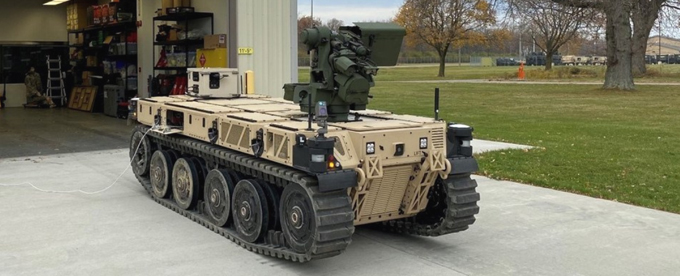2020-12-09
U.S. Army Receives First RCV-L
QinetiQ Inc. and Pratt Miller Defense recently announced the delivery of the first Robotic Combat Vehicle – Light (RCV-L) to the U.S. Army Combat Capabilities Development Command (CCDC) Ground Vehicle Systems Center (GVSC).
The RCV-L is a purpose-built hybrid-electric unmanned ground combat vehicle (UGCV) integrating technology from both organisations.
The first RCV-L was delivered to GVSC on November 5. It is the first of four systems to be delivered. The culmination of eight months of challenging work, this on-time delivery is a milestone for the RCV programme’s industry/government collaboration.
Michael Rose, Branch Chief for Robotic Combat Platforms, GVSC Ground Vehicle Robotics, was quoted saying: “The delivery of the first RCV-L is an exciting result of numerous government organisations and industry working together to achieve our first combat ready robotic vehicle. This unit is the first of four vehicles developed in support of the Manned-Unmanned Teaming (MUM-T) Soldier Operational Experiment, planned for 2022, and represents a significant milestone for the programme. QinetiQ and Pratt Miller have developed and delivered these systems within budget and on-schedule even in the face of the COVID-19 pandemic. The GVSC team now plans to add Autonomous Mobility as well as Government Furnished Software for the Tethered UAS Multi-Mission Payload and CROWS-J Lethality package.”
“We are proud to deliver the first Robotic Combat Vehicle to the U.S. Army,” said Laurent Lannibois, QinetiQ’s RCV Program Manager. “This delivery will provide the Army with an unmanned vehicle ready for integration into ground combat operations. Our team’s ability to deliver this capability on schedule while working through the unexpected challenges of the COVID-19 pandemic is commendable.”
Flexible and Low-risk System
The RCV-L is a purpose-built hybrid-electric unmanned ground combat vehicle (UGCV) configured to meet the specific needs of the programme. It builds upon the proven maturity provided by the Pratt Miller Expeditionary Modular Autonomous Vehicle (EMAV) and integrates QinetiQ’s Modular Open System Architecture (MOSA) robotic control systems to make it both highly flexible, and payload agnostic.
“This is an important step forward for the RCV enterprise and for our Soldiers,” highlighted Brig. Gen. Ross Coffman, director of the Army’s Next Generation Combat Vehicles Cross Functional Team. “We look forward to getting this prototype into the hands of our Soldiers and getting their feedback on how we can best utilise Robotic Combat Vehicles.”
Brian Barr, Pratt Miller Product Manager, commented: “By building upon years of EMAV development, testing, and experimentation with the United States Marine Corps, we were able to provide the Army with a mature low-risk system that exceeds the objective level speed, manoeuvrability, and payload requirements in a single system configuration. The EMAV platform’s modular flat deck architecture has been integrated with over 20 payloads.”
The RCV-L Prototype Project was awarded to QinetiQ North America (now a wholly owned subsidiary of QinetiQ Inc.) with major subcontractor Pratt Miller, in March through the National Advanced Mobility Consortium. The agreement includes the delivery and support of four RCV-L platforms with procurement options for up to 16 additional RCV-L systems.
Closing the Gap
The Robotic Combat Vehicle (RCV) effort, according to Army officials, is currently employing other transaction agreements to conduct experiments to determine the availability and maturity of technologies and the validity of operating concepts. The outcome of these experiments will be used to determine whether an acquisition programme is feasible, with plans for three vehicle variants — a light, a medium, and a heavy variant.
RCV-L is part of the U.S. Army’s larger Next Generation Combat Vehicle (NGCV) programme, under which it will replace and add new combat vehicles. In addition to the RCV-Light, additional contracts have been awarded for RCV-Medium and Heavy versions as well.
Networking is an important capability for the NGCV portfolio not only for secure communications and sharing of information, but also control of autonomous or semi-autonomous vehicles that may eventually be incorporated into operational ground forces, such as Optionally Manned Fighting Vehicle (OMFV) and RCV.
Past modernisation efforts failed, in part, due to challenges maturing networking capabilities. According to programme officials, networked communication is key to connecting the vehicles, and collecting and processing sensor data. However, a mature technology enabling this functionality had not yet been identified. The Network cross-functional team leads Army networking modernisation efforts. Network cross-functional team staff said they are developing technologies to link OMFV and RCV due to the lack of commercially available technologies.
Unmanned NGCV variants will play an important part on the future battlefields in closing this gap. They will contain sensors that can detect smoke and chemicals and be tied into the network. They will also be armed, with the decision to fire being made by humans in the loop.


No Comments